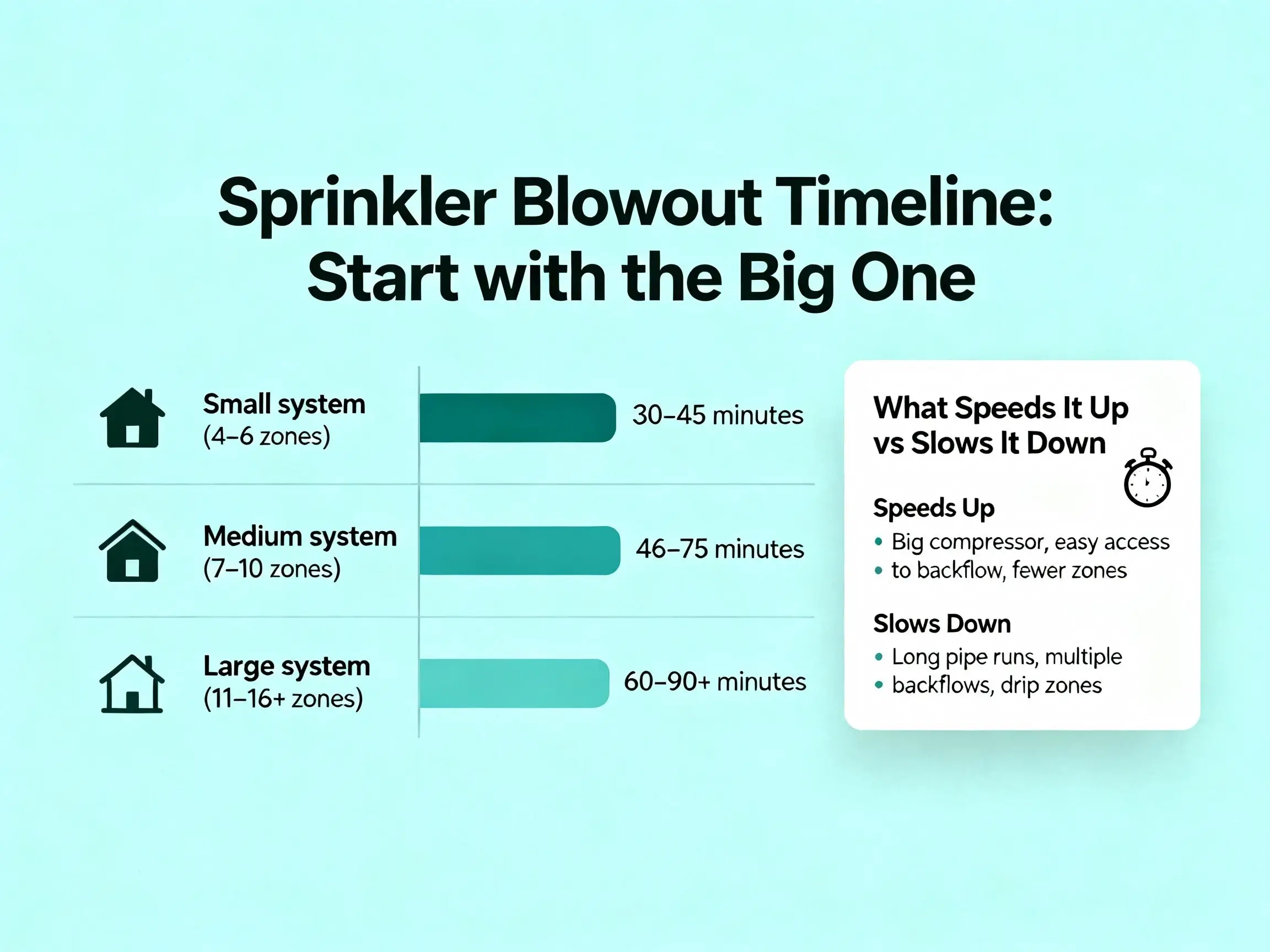
For most homeowners, winterizing a lawn and irrigation system takes about 1.5 to 3 hours. The sprinkler blowout itself typically runs 45–90 minutes for 6–12 zones. Add 20–40 minutes for winterizer fertilizer, 10–20 minutes to drain hoses and protect faucets, plus any leaf or gutter cleanup if you bundle it.
Exact timelines for sprinkler blowouts and lawn winterization
A quick checklist you can follow in order
What speeds things up (and what slows them down)
A weekend game plan by yard size
When to DIY vs hire a pro like Turfrain

If you only do one winterize task, make it the sprinkler system. Water left in lines can crack pipes and valves when temps dip. Here’s the real-world timing:
Small systems (4–6 zones): 30–45 minutes
Medium systems (7–10 zones): 45–75 minutes
Large systems (11–16+ zones): 60–90+ minutes
A quick story: a typical 8-zone, front-and-back setup took us 58 minutes last October—10 minutes to hook up the compressor, roughly 5–7 minutes per zone to push air until the mist turned to dry air, then a final pass to double-check the backflow. That’s what “about an hour” really looks like.
More zones and long pipe runs mean more air time per zone
A big, steady compressor shortens the job — and if you’re wondering whether you can skip it, check out our guide on how to winterize without an air compressor.
Backflow location and easy access can shave off 10 minutes
Drip zones take longer because you use lower pressure and patience
Stack these quick tasks and you’ll feel wildly productive without breaking a sweat.
Bonus tasks if you’ve got time: clear leaf piles off the lawn (prevents smothering) and clean gutters (better runoff when snow melts). These can range from 20 minutes to a couple of hours depending on trees and roofline.
Number of zones: The biggest factor for sprinkler blowouts—more zones, more minutes
Compressor size: A professional, high-CFM unit clears lines faster than a small DIY unit
Layout quirks: Long runs, slopes, and multiple backflow devices add setup and cycle time
Weather window: If a hard freeze is looming, you might combine tasks into one focused session
DIY vs pro: Pros bring speed and consistency; DIY can be slower, especially on your first go
Yard size for fertilizer: 2,500 sq ft? You can be done in 20 minutes. 10,000 sq ft? Block 45+
What doesn’t change much: removing hoses, covering bibs, and emptying small containers—those stay quick almost regardless of property size.
Think of this like setting up dominoes: a few well-timed moves, and everything falls into place.
Sprinkler blowout: 45–90 minutes
Fertilizer application: 20–40 minutes
Hoses, bibs, backflow cover: 15–25 minutes
Quick leaf sweep and mower pass: 20–30 minutes
Day 1: Blowout + bib covers (60–90 minutes)
Day 2: Fertilizer + mower + final tidy (45–75 minutes)
Townhome/small lot: 60–90 minutes total
Typical suburban yard: 1.5–2.5 hours
Large corner lot/acreage: 2.5–4 hours (more walking, more zones)
Prioritize the blowout first—today if possible
Drain hoses and cover bibs immediately after
Fertilizer can wait until the next mild day (ideally before ground freezes)
Have access to the right compressor (or rent one)
Know your backflow and zone layout
Have at least an hour and calm weather
Want it done quickly, cleanly, and safely the first time
Have 10+ zones, complex drip, or a backflow you’re unsure about
Prefer a guaranteed blowout that won’t leave pockets of water behind
Pro tip on timing: Book when overnight lows hit 32–35°F for a few nights in a row. In many regions, that’s late October to mid-November. Schedules fill fast—earlier calls mean better time slots.
Zones purge water, then blow mostly dry air
Backflow is drained and insulated
Controller is off or set to rain/standby
No leaks or hissing after shutoff
Winterizing doesn’t have to eat your weekend. Most lawns and sprinkler systems are done in 1.5–3 hours, especially if you tackle the blowout first and bundle the quick wins. If you want it off your plate entirely, Turfrain is happy to handle it—start to finish, no guesswork. Contact Us, and we’ll get you on the calendar before the frost really bites.